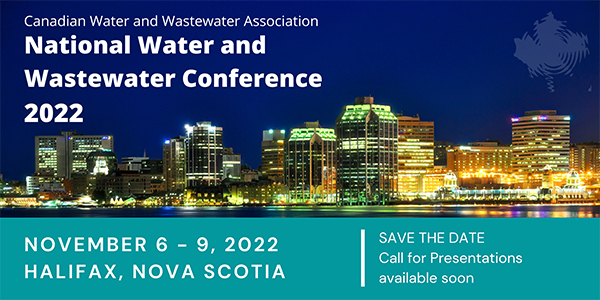 |
||||||||||||||||||||||||||||
| Subscribe | Past Issues | www.cwwa.ca | Water Source Magazine | ||||||||||||||||||||||||||||
|
CWWA News
Each year, the quality of our conference program just seems to get better and better. I was thoroughly amazed by the calibre of our speakers and the depth of discussion. We managed a very respectable turnout as well and we have heard only positive comments from the delegates. Feeling sad that you missed it? Well, one of the good things about virtual events is they are all recorded. So, if you are interested in any of the topics, you can still see the programs form the website www.cwwa.ca and request access to one of the session recordings. Even better, you can attend the next conference live in Halifax this November. March 10 - 11:00 am - 12:30 pm This webinar is a platform to discuss the changing workforce, and how you can plan to address these problems. We’ll also be launching our Workforce Development Guidance document during the webinar. Themes to be explored in the Workshop include:
Federal Initiatives
2,4-D is an herbicide used mainly to control broadleaf weeds. In 2018 (the most recent year for which data are available), it was one of the top 10 active ingredients sold in Canada. The maximum acceptable concentration (MAC) for 2,4-D in drinking water - now set at: 0.10 mg/L (100 μg/L) – is considered to be protective against health effects from exposure to 2,4-D in drinking water over a lifetime. Health Canada, in collaboration with the Federal-Provincial-Territorial Committee on Drinking Water, recently posted notice that it is withdrawing the existing Guidelines for Canadian Drinking Water Quality (GCDWQ) for 17 chemical substances, including 13 pesticides. It was determined that the GCDWQ are no longer required since these contaminants are unlikely to be found in Canadian drinking water at levels that may pose a risk to human health. On January 27, 2022, the Minister of Environment and Climate Change announced that the second round of applications is open for $200 million through the Low Carbon Economy Fund’s Champions stream, which supports a wide range of local pollution-cutting initiatives in communities CWWA members received a detailed communique on the funding opportunity, as they may have projects that would qualify for the program.
March 21 and 22, in two 1.5-hour installments, the CWWA will host international experts in a virtual symposium on the topic of ensuring safe drinking water through drinking water quality management. Presenters will discuss approaches to quality management and continuous improvement, share practical experience and successes, and discuss challenges. Our full speaker line up and a summary of the presentations is available on the CWWA website. Registration is free and you can sign up today! Member News
Given the challenging state of global affairs, state agencies in the US have notified those who operate critical infrastructure to be diligent in protecting their security. There’s a need for “maintain a heightened awareness for possible intrusions into operational networks and to prepare to maintain critical operations if process control networks are disabled.” USEPA provided a link with cyber resilience resources and best practices for the water sector that may help folks:
The Walkerton Clean Water Centre (WCWC) is excited to announce that Brian Bates will be returning to Walkerton to lead the team as CEO effective February 22, 2022. Brian is passionate about the water industry, with proven leadership abilities and strong business acumen. He has worked in the industry for more than 20 years, including his time serving as Manager of Training and Development at WCWC from 2019 until 2020.
Inverness County, Canada’s Musical Coast, comprises the entire western coastline of Cape Breton Island, including the world famous Cabot Trail and reaches inland as far as the beautiful Bras d’Or Lakes. Canada’s Musical Coast is a string of beautiful communities and majestic coastline vistas bound together by musical traditions.
Dryden is the second-largest city in the Kenora District of Northwestern Ontario, Canada, located on
Provincial News
The best practices and practical approaches contained in this proposed Guide are intended to outline a general framework for subwatershed planning featuring information on, among other things:
The discussion paper sets out the challenges and opportunities for improving municipal wastewater and stormwater management in Ontario, with each chapter ending with a set of discussion questions. Thousands of people who have been affected by years-long drinking water advisories could see On December 24, 2021 Canada's Federal Court and Manitoba's Court of Queen's Bench issued a joint decision approving the settlement in two national class-action lawsuits launched against the federal government by First Nations living under drinking water advisories. In Tataskweyak Cree Nation v. Canada (Attorney General), the Courts determined that, in addition to an infrastructure commitment of at least $6 billion to support reliable access to safe drinking water on reserves, $1.5 billion should be awarded in compensation to individuals deprived of clean drinking water; The court determined the First Nations Drinking Water Settlement Agreement to be “fair and reasonable and in the best interests of the Class as a whole.” British Columbia recently announced that it is developing its first Watershed Security Strategy and Fund. The first step is to explore key themes, including governance, climate change, ecosystems and sources of drinking water, as well as community and economic stability, through the release of a discussion paper for feedback. The deadline for public comment on the discussion paper is March 18, 2022. Snippings & Clippings
Washington Post Over the next 30 years, shorelines in the United States are projected to see water levels rise by 12 inches. Coastal communities around the country will continue to be threatened by flooding and erosion, says a report by the National Oceanic and Atmospheric Administration. CTV News Quebec environment groups say they are going to court to lift the veil on the millions of litres of water collected by Coca-Cola, Pepsi, Naya, Eska and others every year. The Canadian Press has learned that the case will be heard on March 1. WGRT Democratic Congressman Dan Lowenthal of California and local Republican Representative Lisa McLain of Michigan 10th District have introduced the Protecting Infrastructure and Promoting Environmental Stewardship (PIPES) Act in the U.S. House of Representatives. ES&E Magazine The risk of stomach bugs may increase after heavy storms, says a new study of environmental and health data in four North American cities around the Great Lakes, suggesting that more centralized data sharing could benefit human health. ES&E Magazine 18 municipalities in Ontario will see an investment of $15 million by the province to optimize stormwater and wastewater infrastructure, with an additional $10 million to upgrade sewage monitoring and public reporting capacity. The Record An economic model found that Ontario’s wetlands provide $4.2 billion worth of natural filtration to keep drinking water clean. “People don’t care about these wetlands that much, they think that these are wastelands and we can convert them to make shopping malls,” said Tariq Aziz, a post-doctoral fellow in University of Waterloo’s Department of Earth and Environmental Science. Associated Pres Angela Stamps won’t drink water from her faucet, showers less and no longer takes the baths she once found relaxing. She doesn’t cook with tap water and sometimes skips rinsing her produce. Even though the amount of lead in Flint, Michigan’s tap water has been well below a key state threshold for several years, she hasn’t been able to stop worrying since going through the trauma of the city’s lead crisis. |
||||||||||||||||||||||||||||


thumb.jpg)





